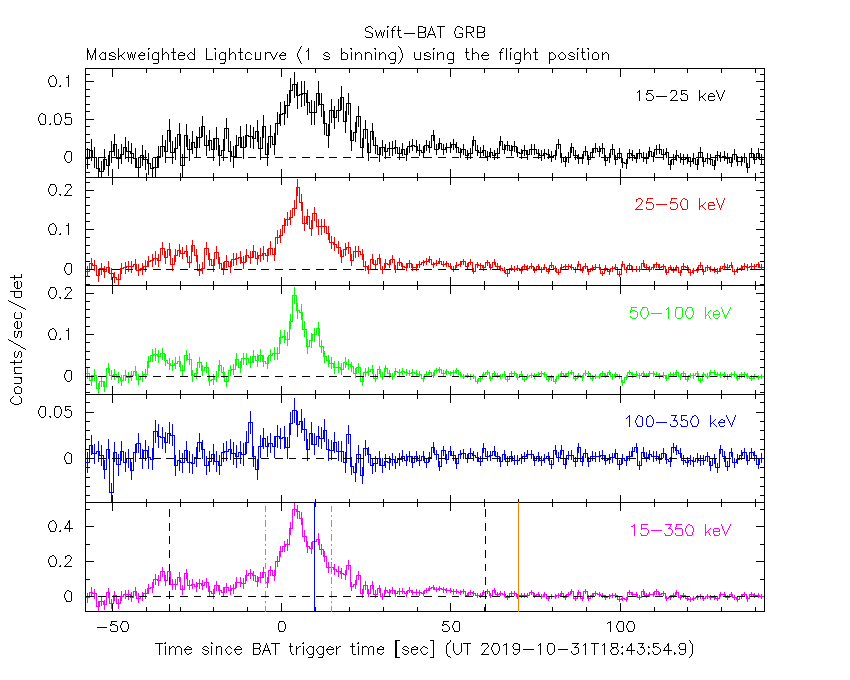
E. Ambrosi (INAF-IASFPA), D.N. Burrows (PSU) and J.D. Gropp (PSU) for the Swift team
At 18:43:54 UT, the Swift Burst Alert Telescope (BAT) triggered and located GRB 191031C (trigger=932595) (Ambrosi et al. GCN Circ. 26108). Swift slewed immediately to the burst. At the time of the trigger, the initial BAT position was 82° from the Sun (6.7 hours West) and 92° from the 16%-illuminated Moon. Table 1 contains the best reported positions from Swift, and the latest XRT position can be viewed at http://www.swift.ac.uk/xrt_positions.
Gropp and Ambrosi (GCN Circ. 26127) reported the detection with UVOT of an optical afterglow. Table 2 is a summary of GCN Circulars about this GRB from observatories other than Swift.
Standard analysis products for this burst are available at https://gcn.gsfc.nasa.gov/swift_gnd_ana.html.
As reported by Palmer et al. (GCN Circ. 26132),
the BAT ground-calculated position is RA, Dec = 115.880, -62.322 deg which is RA(J2000) = 0
The mask-weighted light curve (Figure 1) shows several peaks.
The first begins around T-40 s and runs until T-20 s.
The second, brightest, peak begins immediately after, peaks around T+5 s, and decays to background by T+120 s.
There are several weak peaks superimposed on this one, the largest coming around T+45 s.
The time-averaged spectrum from T-37.98 to T+112.66 s is best fit by a simple power-law model.
The power law index of the time-averaged spectrum is 1.60 ± 0.07.
The fluence in the 15-150 keV band is 7.2 ± 0.3 x 1
The results of the batgrbproduct analysis are available at https://gcn.gsfc.nasa.gov/notices_s/932595/BA/.
Analysis of the initial XRT data was reported by Burrows et al. (GCN Circ. 26130). We have analysed 9.8 ks of XRT data for GRB 191031C, from 87 s to 173.3 ks after the BAT trigger. The data comprise 1.6 ks in Windowed Timing (WT) mode with the remainder in Photon Counting (PC) mode. The enhanced XRT position for this burst was given by Goad et al. (GCN Circ. 26109).
The late-time light curve (Figure 2) (from T0+6.6 ks) can be modelled with a power-law decay with a decay index of α=1.19 (+0.09, -0.08).
A spectrum formed from the WT mode data can be fitted with an absorbed power-law with a photon spectral index of 1.99 (+0.08, -0.06). The best-fitting absorption column is 1.87 (+0.28, -0.08) x 1
A summary of the PC-mode spectrum is thus:
Total column: 1.8 (+0.4, -0.0) x 1
Galactic foreground: 1.8 x 1
Excess significance: <1.6 σ
Photon index: 1.79 (+0.12, -0.05)
The results of the XRT team automatic analysis are available at http://www.swift.ac.uk/xrt_products/00932595.
The Swift/UVOT began settled observations of the field of GRB 191031C 91 s after the BAT trigger
(Gropp and Ambrosi GCN Circ. 26127).
A source consistent with the XRT position (Goad et al. GCN Circ. 26115) is detected in the initial UVOT exposures.
Table 3 gives preliminary
magnitudes using the UVOT photometric system
(Breeveld et al. 2011, AIP Conf. Proc., 1358, 373).
No correction has been made for the expected extinction in the Milky Way
corresponding to a reddening of

Figure 1. The BAT
mask-weighted light curve in the four individual and total
energy bands. The units are counts

Figure 2. The XRT light curve.
Any data from a crosshatched region are not included in the fit.
| RA (J2000) | Dec (J2000) | Error | Note | Reference |
|---|---|---|---|---|
| 0 |
-62°19'29.9" | 1.7" | XRT-final | UKSSDC |
| 0 |
-62°19'28.8" | 1.8" | XRT-enhanced | Goad et al. GCN Circ. 26115 |
| 0 |
-62°19'20.1" | 1.3' | BAT-refined | Palmer et al. GCN Circ. 26132 |
| Band | Authors | GCN Circ. | Subject | Observatory | Notes |
|---|---|---|---|---|---|
| Gamma-ray | Fermi | 26107 | Fermi GBM Final Real-time Localization | Fermi GBM | |
| Gamma-ray | Fermi | 26111 | Fermi GBM Final Real-time Localization | Fermi GBM | |
| Gamma-ray | Fletcher et al. | 26119 | Fermi GBM detection | Fermi GBM | Fluence=1.33±0.06x1 (8 |
| Gamma-ray | Luo et al. | 26146 | Insight-HXMT/HE detection | Insight-HXMT |
| Filter | Exp(s) | Mag | ||
|---|---|---|---|---|
| u | 307 | 556 | 245 | >19.71 |
| white | 92 | 242 | 147 | 20.27± 0.32 |
| white | 862 | 1011 | 147 | >20.39 |
Table 3. UVOT observations reported by Gropp and Ambrosi (GCN Circ. 26127). The start and stop times of the exposures are given in seconds since the BAT trigger. The preliminary detections and 3-σ upper limits are given. No correction has been made for extinction in the Milky Way.
November 3, 2019